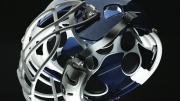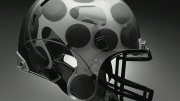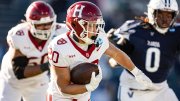“I can think of two hits in particular I took at Harvard that would qualify as concussive episodes, although I didn’t say anything to anyone,” says Vin Ferrara ’95, who quarterbacked the 1994 and 1995 Crimson varsities. “So of course they weren’t diagnosed.” Ferrara, who earned an M.D. and M.B.A. from Columbia in 2004, founded a company, Xenith, that year to manufacture a new type of football helmet: one that could help insulate the brain from the sudden movements of the head during impact that result in concussions. In the last few years, the sports world seems to have caught up with his product.
In October, the issue of football-induced concussions and related brain trauma reached Congress, where former players and neuropathologists testified before a House committee and legislators took National Football League (NFL) commissioner Roger Goodell to task on the matter. “In the last three years, there’s been an explosion of awareness of how severe concussions and even sub-concussive trauma truly are,” says New York Times reporter Alan Schwarz, who was nominated for a 2007 Pulitzer Prize for his articles on football concussions, a topic he continues to cover. “It used to be considered just a rite of the game. Now we’re finding out that getting ‘dings’ or concussions is incredibly dangerous and can even be fatal.”
Among those testifying before Congress was former Harvard defensive tackle Chris Nowinski ’00, whose 2006 book Head Games: Football's Concussion Crisis from the NFL to Youth Leagues described his own traumatic experiences and spotlighted the issue. Nowinski wasn’t diagnosed with a concussion on the gridiron, but he took blows to the head in his subsequent career as a pro wrestler. (“The difference between a real kick and a ‘pro wrestling’ kick can be three inches,” he explains. “Sometimes they land for real.”) He blacked out at times in the ring, and says his last concussion left him with five years of “post-concussive syndrome.” Only in the last year have Nowinski’s headaches come under control, and he no longer needs medication for the sleepwalking that developed as a sequela.
Nowinski co-founded the Sports Legacy Institute (sportslegacy.org) with Dr. Robert Cantu of Boston University School of Medicine to encourage the study of chronic traumatic encephalopathy, or CTE, a degenerative brain disease caused by repeated head trauma. (Xenith helps support the institute, and also conducts its own education program for athletes, coaches, and officials on risk reduction in sports.) “We are 11 for 11 in finding CTE in ex-college and pro players,” Nowinski says, referring to autopsy data that identified the abnormal protein tau, a marker of CTE that cannot be imaged and so depends on post-mortem diagnosis. (More than 200 athletes to date have volunteered to donate their brains for research via the institute.) The diagnosis “punch drunk,” or dementia pugilistica, first made in the case of a boxer in 1928, is an earlier name for CTE; its symptoms include memory loss, confusion, impaired judgment, paranoia, impulse control problems, aggression, depression, and eventually, progressive dementia.
Concussions are poorly understood, widely under-reported, and often not diagnosed at all. “Most people think of concussions in terms of energy force and shock,” Ferrara says. The popular concept is of a local “bruise to the brain” caused by the impact of tissue slamming into the skull. In fact, concussions result from shearing forces that violent movement imparts to the brain’s nerve cells, and affect a large, diffuse area of the brain, not a single location. One useful image compares the head to an egg: the shell may not break, but the yolk inside still undergoes a violent displacement.
Football players, historically, have referred to being “dinged” or having one’s “bell rung” for moments of dizziness, confusion, or grogginess that can follow a blow to the head. These terms are “classic slang expressions for concussion,” says Ferrara, who prefers the term “concussive episodes.” Loss of consciousness and amnesia, the traditional diagnostic criteria, are actually quite rare. Symptoms can range from three seconds of blurred vision to unconsciousness and prolonged headaches or cognitive dysfunction. A working paper from Xenith asserts that concussive episodes affect from 45 percent to 75 percent of football players in the course of a single season, and that most players will suffer multiple episodes. The primary cause is head-first contact, especially helmet-to helmet impact, though many kinds of hits, like a blind-side slam into a receiver’s gut that snaps his head suddenly forward or back, can cause the injury.
The Xenith helmet’s design tries to minimize any sudden head movement during impact by using air cells that act as shock absorbers, much the way automobile air bags protect bodies in a crash. Where standard football helmets are lined with dense padding, Xenith headgear has “air cells that collapse and vent air to dissipate the energy of impact,” Ferrara explains. “They act like a bicycle pump—the harder the impact, the more pressure they resist with. The key is the adaptive response…a more optimized compression so that the head moves more gradually upon impact, and the brain should move less inside the skull. The real goal is to address the chronic effects of repeated impacts by managing each impact better and educating people to reduce the number of these impacts in the first place.”
At $350 for an adult model, Ferrara’s helmets are only marginally more expensive than standard helmets priced at $200 to $300. Close to 15,000 of them have been used during the five fall and spring football seasons since 2007, at levels from youth football to the NFL. (The vast majority of the five million U.S. football players compete at the youth and high-school level.) Research on the helmets’ effectiveness cannot use placebos, as players know what kind of gear they are wearing, but the firm’s small 2008 survey of 65 players on 10 teams showed a significantly reduced risk of headaches (a key symptom) and reduced perception of impact. “The data suggest,” says a Xenith summary document, that the helmet “may reduce the risk of concussive episodes in football players by 50 percent or more.”
In any case, the product is catching on with Crimson athletes: 17 of the current 114 Harvard varsity footballers wear Xeniths. Last year’s standout quarterback, Chris Pizzotti ’08 (’09), wore one, as does current Buffalo Bills quarterback Ryan Fitzpatrick ’05. Two-time all-Pro center Matt Birk ’98 of the Baltimore Ravens (who played two Harvard seasons with Ferrara) is using a Xenith this year. “Safety is a big thing with me, and with all players,” Birk said at midseason. “I’ve been really happy with the Xenith. On the football field, you get what’s called a ding—you might feel a little foggy after a hit. I haven’t had any of these with the new helmet. Normally, I would expect it by now, and probably more than once.”











